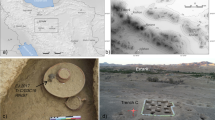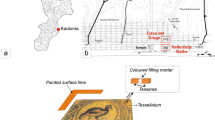Abstract
Several plaster samples were collected from the wall paintings of post-Byzantine monuments from Kastoria town, northern Greece. They were analysed mainly by simultaneous thermal analysis (TG-DTG/DTA) and X-ray diffraction and supplementary by electron microscope (ESEM-EDX) and Raman spectroscopy. Whitish and dark plaster layers were evident in most cases. Calcite, micas, and quartz were the dominant minerals, while dolomite, gypsum, and feldspar were detected as minor phases in most of the samples. Hydromagnesite and chlinochlore were also determined in a few samples. The utilisation of the results for chronological purposes (i.e. for assignment of different painting periods) was also suggested and the presence of dolomite and hydromagnesite could be characteristic for the provenance of the raw material. Gypsum was regarded mainly as a weathering product due to sulfation process, and secondly as a binding material of the plaster. The thermoanalytical results are in good agreement with the mineralogical data. The white plasters are categorized as hydraulic lime mortars, while the dark ones as natural pozzolanic mortars. Calcite and gypsum correlates well with their respective mass losses at certain temperature ranges and their Raman spectra are clearly detected. ESEM-EDX revealed fine calcareous components with aluminolisilicate aggregates and the application of the fresco technique either as a multi-layer or a single-layer plaster. The deterioration caused by salts (gypsum, halite, and nitratine) and micro-organisms was also determined. The detrimental effect of the salt crystallization and dissolution was also confirmed using the so-called Peltier-stage experiment.








Similar content being viewed by others
References
Moropoulou A, Bakolas A, Bisbikou K. Characterization of ancient, byzantine and later historic mortars by thermal and X-ray diffraction techniques. Thermochim Acta. 1995;269/270:779–95.
Moropoulou A, Bakolas A, Bisbikou K. Investigation of the technology of historic mortars. J Cult Herit. 2000;1:45–58.
Moropoulou A, Bakolas A, Anagnostopoulou S. Composite materials in ancient structures. Cem Concr Compos. 2005;27:295–300.
Genestar C, Pons C. Ancient covering plaster mortars from several convents and Islamic and Gothic palaces in Palma de mallorca (Spain). Analytical characterization. J Cult Herit. 2003;4:291–8.
Middendorf B, Hughes JJ, Callebaut K, Baronio G, Papayianni I. Investigative methods for the characterisation of historic mortars- Part 1: mineralogical characterization. Mater Struct. 2005;38:761–9.
Clark RJH. Raman microscopy as a structural and analytical tool in the fields of art and archaeology. J Mol Struct. 2007;74–80:834–6.
Edwards HG, Farwell DW. The conservational heritage of wall paintings and buildings: an FT-Raman spectroscopic study of prehistoric, Roman, mediaeval and Renaissance lime substrates and mortars. J Raman Spectrosc. 2008;39:985–92.
Hernanz A, Gavira-Vallejo JM, Ruiz-Lopez JF, Edwards HGM. A comprehensive micro-Raman spectroscopic study of prehistoric rock paintings from the Sierra de las Cuerdas, Cuenca, Spain. J Raman Spectrosc. 2008;39:972–84.
Iordanidis A, Garcia-Guinea J, Karamitrou-Mentessidi G. Analytical study of ancient pottery from the archaeological site of Aiani, northern Greece. Mater Charact. 2009;60:292–302.
Sandrolini F, Franzoni E. Characterization procedure for ancient mortars’ restoration: the plasters of the Cavallerizza courtyard in the Ducal Palace in Mantua (Italy). Mater Charact. 2010;61:97–104.
Bakolas A, Biscontin G, Moropoulou A, Zendri E. Characterization of structural byzantine mortars by thermogravimetric analysis. Thermochim Acta. 1998;321:151–60.
Maravelaki-Kalaitzaki P, Bakolas A, Karatasios I, Kilikoglou V. Hydraulic lime mortars for the restoration of historic masonry in Crete. Cem Concr Res. 2005;35:1577–86.
Anastasiou M, Hasapis Th, Zorba T, Pavlidou E, Chrissafis K, Paraskevopoulos KM. TG-DTA and FTIR analyses of plasters from byzantine monuments in Balkan region, comparative study. J Therm Anal Calorim. 2006;84:27–32.
Daniilia S, Minopoulou E, Andrikopoulos KS, Tsakalof A, Bairachtari K. From Byzantine to post-Byzantine art: the painting technique of St Stephen’s wall paintings at Meteora, Greece. J Archaeol Sci. 2008;35:2474–85.
Pavlidou E, Arapi M, Zorba T, Anastasiou M, Civici N, Stamati F, Paraskevopoulos KM. Onoufrios, the famous XVI’s century iconographer, creator of the “Berati School”: studying the technique and materials used in wall paintings of inscribed churches. Appl Phys A. 2006;83:709–17.
Orlandos A. Byzantine monuments of Kastoria; Archeion ton Byzantinon mnimeion tis Ellados, 4 (ABME A’); 1938.
Tsigaridas E. The monumental painting of the byzantine churches in Kastoria, In Macedonian Hellenism; Melbourne; 1995. pp. 384–93.
Bartz W, Filar T. Mineralogical characterization of rendering mortars from decorative details of a baroque building in Kożuchów (SW Poland). Mater Charact. 2010;61:105–15.
Bianchini G, Marrocchino E, Vaccaro C. Chemical and mineralogical characterisation of historic mortars in Ferrara (northeast Italy). Cem Concr Res. 2004;34:1471–5.
Genestar C, Pons C, Mas A. Analytical characterisation of ancient mortars from the archaeological Roman city of Pollentia (Balearic Islands, Spain). Anal Chim Acta. 2006;557:373–9.
Rizzo G, Megna B. Characterization of mortars from ancient and traditional water supply systems in Sicily. J Therm Anal Calorim. 2008;92:173.
Gleize PJP, Motta EV, Silva DA, Roman HR. Characterization of historical mortars from Santa Catarina (Brazil). Cem Concr Compos. 2009;31:342–6.
Cardiano P, Sergi S, De Stefano C, Ioppolo S, Piraino PJ. Investigations on ancient mortars from the basilian monastery of Fragala. Therm Anal Calorim. 2008;91:477–85.
Duran A, Robador MD, Jimenez de Haro MC, Ramirez-Valle V. Study by thermal analysis of mortars belonging to wall paintings corresponding to some historical buildings of Sevillian art. J Therm Anal Calorim. 2008;92:353–9.
Papadopoulou DN, Lalia-Kantouri M, Kantiranis N, Stratis JA. Thermal and mineralogical contribution to the ancient ceramics and natural clays characterization. J Therm Anal Calorim. 2006;84:39–45.
Adriano P, Santos Silva A, Veiga R, Mirao J, Candeias AE. Microscopic characterisation of old mortars from the Santa Maria Church in Évora. Mater Charact. 2009;60:610–20.
Hein A, Karatasios I, Mourelatos D. Byzantine wall paintings from Mani (Greece): microanalytical investigation of pigments and plasters. Anal Bioanal Chem. 2009;395:2061–71.
Alvarez JI, Navarro I, Garcia Casado PJ. Thermal, mineralogical and chemical studies of the mortars used in the cathedral of Pamplona (Spain). Thermochim Acta. 2000;365:177–87.
Duran A, Perez-Maqueda LA, Poyato J, Perez-Rodriguez JL. A thermal study approach to Roman age wall painting mortars. J Therm Anal Calorim. 2010;99:803–9.
Sabbioni C, Zappia G, Ghedini N, Gobbi G, Favoni O. Black crusts on ancient mortars. Atmos Environ. 1998;32:215–23.
Moropoulou A, Polikreti K, Ruf V, Deodatis G. San Francisco Monastery, Quito, Equador: characterisation of building materials, damage assessment and conservation considerations. J Cult Herit. 2003;4:101–8.
Lindh U. Uptake of elements from a biological point of view. In: Selinus O, et al., editors. Essentials of medical geology. Amsterdam: Elsevier; 2005. p. 87–114.
Socrates G. Infrared and Raman characteristic group frequencies; tables and charts. Chichester: Wiley; 2001.
Smith GD, Clark RJH. Raman microscopy in archaeological science. J Archaeol Sci. 2004;3:1137–60.
Acknowledgements
We acknowledge the financial support of project CGL2009-09247 of the Spanish Plan Nacional I+D+i and the SYNTHESYS Project ES-TAF-258 of the European Community, giving access to the research infrastructures of the Museo Nacional de Ciencias Naturales (MNCN), Madrid, Spain. The technicians Rafael Gonzales-Martin, Laura Tormo, and Manuel Castillejo Magarin of the MNCN are gratefully acknowledged.
Author information
Authors and Affiliations
Corresponding author
Rights and permissions
About this article
Cite this article
Iordanidis, A., Garcia-Guinea, J., Strati, A. et al. Thermal, mineralogical and spectroscopic study of plasters from three post-Byzantine churches from Kastoria (northern Greece). J Therm Anal Calorim 103, 577–586 (2011). https://doi.org/10.1007/s10973-010-1055-7
Received:
Accepted:
Published:
Issue Date:
DOI: https://doi.org/10.1007/s10973-010-1055-7




